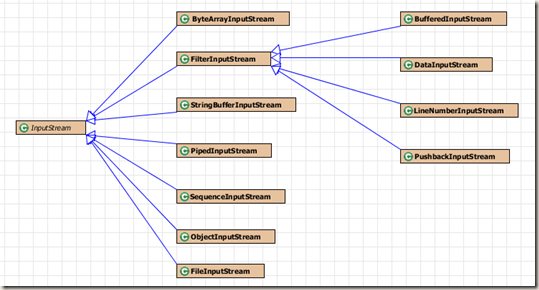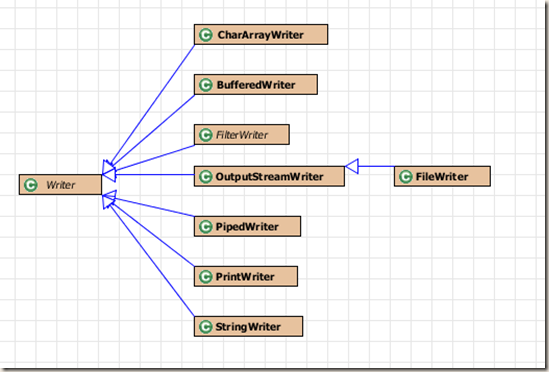现实世界中我们总要处理不同的数据源:
- 字节数组。
- String对象
- 文件。
- “管道”,工作方式与实际管道相似。
- 一个有其他种类组成的序列。
- 其他数据源,如Interent连接等。 --From 《Java编程思想》
对于以上的数据源,Java io都提供了相对应的流处理类,如读取文件数据源FileInputStream,FileOutputStream,这些类都继承了InputStream这个抽象类,并重新实现了主要的接口。作为Java io的学习篇,这里主要分析了面向字节的io和面向字符的io。
面向字节
面向字节顾名思义他们在处理数据流时,是以字节为单位的。这些流处理类继承了InputStream和OutputStream两个抽象类。下面简单看下这两个父类具有的接口
InputStream
public abstract int read() /*从输入流中读取相同个字节到b中,返回实际读取字节的个数,可能小于b的长度*/ public int read(byte b[]) /*读取最多len个字节到字节数组b中,且读取的第一个自己存放在b[off],返回实际读取的字节个数*/ public int read(byte b[], int off, int len) /*从输入流中跳过n字节,返回实际跳过的字节长度*/ public long skip(long n) /*标记当前输入流的位置,结合reset函数使用,readlimit参数指明在mark失效之前,可从流中读取的字节长度*/ public synchronized void mark(int readlimit) public synchronized void reset() /*查看是否支持mark功能*/ public boolean markSupported()
以上是InputStream所具有的接口,最主要的函数功能便是从流中读取数据,其子类都该函数都有各自实现。下图为继承了InputStream的一些子类(仅存在于io包内的类),其中FilterInputStream是一个装饰器类,他持有一个InputStream对象,所以继承了FilterInputStream的类可以添加其他的功能。这就是为什么我们经常会用到将各种流组合使用的原因。
BufferedInputStream bis = new BufferedInputStream(new FileInputStream(new File("")));

OutputStream
/*将b的低8位写到输出流中*/ public abstract void write(int b) throws IOException /*将b字节数组写到输出流中*/ public void write(byte b[]) throws IOException /*以off为b的起点,将len个长度的字节写入到输出流中*/ public void write(byte b[], int off, int len) throws IOException
可以看到OutputStream的接口就是将字节写入到输出流中,对于不同的数据源OutputStream同样有相应的子类。类似于FilterInputStream,FilterOutputStream同样是一个装饰器类以组合其他的流实现不同的功能。另外,我们常用的System.out对象就是一个PrintStream实例。
下面简单介绍下一些类的作用:
ByteArrayInputStream/ByteArrayOutputStream从缓冲区字节数组中读取到流/将流写到缓冲区字节数组(一种数据源)。
FileInputStream/FileOutputStream从文件读取数据到流/或将流写到文件中(数据源),经常搭配FileOutputStream使用。
DataInputStream/DataOutputStream以可移植的方式从流长读取/写入基本类型数据(int,char,long)。
BufferedInputStream/BufferedOutputStream每次读取/写入缓冲区(默认8k),避免每次进行实际操作,提高效率。
一个深拷贝的输入输出流示例,写入到byte数组中,同样也可以写入到其他流中:
public Object deepCopy() throws Exception{ //ByteArrayOutputStream ByteArrayOutputStream bo = new ByteArrayOutputStream(); ObjectOutputStream oo = new ObjectOutputStream(bo); oo.writeObject(this); //读出二进制流产生的新对象 ByteArrayInputStream ba = new ByteArrayInputStream(bo.toByteArray()); ObjectInputStream oi = new ObjectInputStream(ba); return oi.readObject(); }
面向字符
以字符为单位处理流,有输入流抽象类Reader、输出流抽象类Writer。Reader、Writer并不能完全取代InputStream、OutputStream,但能更方便的对文本和字符类型的数据进行操作(支持Unicode,java的char是Unicode的)。Reader、Writer有类似于InputStream、OutputStream的接口,主要就是将byte操作改变成char操作,就不一一列出。
Reader:
protected Object lock; public int read(java.nio.CharBuffer target) throws IOException
Reader提供了一个lock锁属性,和read到CharBuffer的操作。lock默认是Reader对象本身(this),这样SubClass便可以使用这个对象来同步流的操作,这能达到更细粒度的同步操作(以后学习线程同步再来详细介绍,这里就先忽略)。同样CharBuffer在学习nio再来介绍。
来看一下Reader的继承结构:
大多数类都与Stream类相对应,就不详细解释具体用法了。需要注意打是,InputStreamReader使用StreamDecoder类可以将字节流转换到字符流,所以有如下用法:
BufferedReader bReader = new BufferedReader(new InputStreamReader(System.in));
Writer:
private char[] writeBuffer; protected Object lock; abstract public void write(char cbuf[], int off, int len) throws IOException; public void write(String str, int off, int len) throws IOException /*相当于write(csq.toString())*/ public Writer append(CharSequence csq) throws IOException
Writer增加了一些对String和CharSequence的写操作,writeBuffer用来暂时存放要被写入流的字符串或字符数组,其余的接口类似于OutputStream。Writer的类继承结构如下:
还是直接举一些流操作的例子,这些例子来自《Java编程思想》。这些流类需要结合使用,才能发挥其最大的功能
public class BufferedInputFile { public static void main(String[] args) { //System.out.print(read("BufferedInputFile.java")); //memoryInput(read("BufferedInputFile.java")); //basicFileOut("BufferedInputFile.java"); storingAndRecoveringData(); } //缓冲输入文件 public static String read(String file) { BufferedReader bReader; StringBuilder sb = new StringBuilder(); try { bReader = new BufferedReader(new FileReader(file)); String s; while((s=bReader.readLine()) != null){ sb.append(s + " "); } bReader.close(); } catch (IOException e) { // TODO Auto-generated catch block e.printStackTrace(); } return sb.toString(); } //内存输入 public static void memoryInput(String str){ try { StringReader srReader = new StringReader(str); int c; while((c=srReader.read()) != -1) System.out.print((char)c); srReader.close(); } catch (IOException e) { // TODO Auto-generated catch block e.printStackTrace(); } } //格式化的内存输入 public static void formattedMemoryInput(byte[] b){ DataInputStream in = new DataInputStream( new ByteArrayInputStream(b)); try { while(in.available() != 0) //慎用available读取媒介不用,实现不同 System.out.print((char)in.readByte()); in.close(); } catch (IOException e) { // TODO Auto-generated catch block System.out.println("end"); } } //基本文件输出, 实际上文件输出常使用bufferedwriter,以得到更好的性能 public static void basicFileOut(String file){ try { BufferedReader in = new BufferedReader(new FileReader(file)); PrintWriter pWriter = new PrintWriter(new FileWriter("test.txt")); int lineCount = 1; String string = ""; while((string=in.readLine()) != null) pWriter.println(lineCount++ + ":" + string); pWriter.close(); in.close(); System.out.print(read("test.txt")); } catch (IOException e) { // TODO Auto-generated catch block e.printStackTrace(); } } //存储和恢复数据 DataOutputStream DataInputStream结合使用可以保证准确的读取数据 public static void storingAndRecoveringData(){ try { DataOutputStream outputStream = new DataOutputStream( new BufferedOutputStream(new FileOutputStream("data.txt"))); outputStream.writeDouble(3.1415926); outputStream.writeUTF("what a f"); outputStream.writeUTF("hello world"); outputStream.close(); DataInputStream in = new DataInputStream(new FileInputStream("data.txt")); System.out.println(in.readDouble()); System.out.println(in.readUTF()); System.out.println(in.readUTF()); in.close(); } catch (IOException e) { // TODO Auto-generated catch block e.printStackTrace(); } } }
RandomAccessFile
RandomAccessFile适用于大小已知的记录组成的文件,可以使用seek()方法将记录转移。RandomAccessFile仅实现了DataInput和DataOutput接口(故有很多readDouble(),writeDouble()等操作),与InputStream和OutputStream没有关系。
在JDK1.4中,RandomAccessFile的大多数功能被nio存储映射文件取代。
看一个实际操作例子:
public static void usingRandomAccessFile(String file){ try { RandomAccessFile rFile = new RandomAccessFile(file, "rw"); //rw读写 for(int i=0; i<7; ++i){ rFile.writeDouble(i*1.414); } rFile.writeUTF("end"); rFile.close(); display(file); rFile = new RandomAccessFile(file, "rw"); rFile.seek(5*8); rFile.writeDouble(47.000144); rFile.close(); display(file); } catch (IOException e) { // TODO Auto-generated catch block e.printStackTrace(); } } public static void display(String file) throws IOException { RandomAccessFile rFile = new RandomAccessFile(file, "r"); //r仅读 for (int i = 0; i < 7; ++i) { System.out.println("value " + i + ": " + rFile.readDouble()); } System.out.println(rFile.readUTF()); rFile.close(); } public static void main(String[] args) { usingRandomAccessFile("hh.txt"); }
OUTPUT
value 0: 0.0
value 1: 1.414
value 2: 2.828
value 3: 4.242
value 4: 5.656
value 5: 7.069999999999999
value 6: 8.484
end
value 0: 0.0
value 1: 1.414
value 2: 2.828
value 3: 4.242
value 4: 5.656
value 5: 47.000144
value 6: 8.484
end


